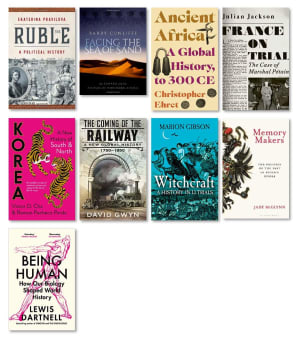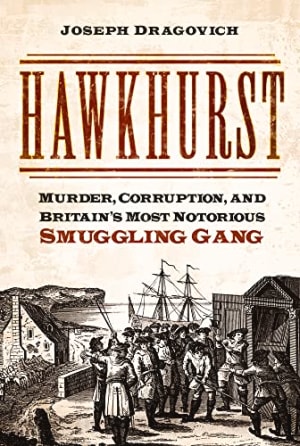London has been invaded.
Rank upon rank of enemy troops march through the capital. Prominent politicians are being beheaded on a balcony overlooking a busy street, while others hang by the neck from a lamppost. The Prince of Wales has been thrown headfirst out of a window to his death. The Leader of the Opposition in Parliament has stripped the Prime Minister naked, tied him to a pole in the middle of the street, and is flogging him mercilessly.
Before you start running for the hills: don’t worry - this terrifying scene is an invention of the late 18th century artist and satirist James Gillray. But it would have seemed alarmingly plausible to Britons when it was published in 1796, as the French under Napoleon built up a formidable army on the other side of the channel.

Detail from Promis’d Horrors of the French Invasion, or Forcible reasons for negotiating a regicide peace by James Gilray, 1796 © British Museum
The picture I have shown above is the centre of the print. James Fox, longtime leader of the opposition with his characteristic giant eyebrows, is flagellating William Pitt, the Prime Minister and main architect of Britain’s war against revolutionary France.
It is well worth having a look at the original image of Promis’d Horrors of the French Invasion by James Gillray on the British Museum website so you can pan around, zoom in and take in all the delightful and gory details.
Twenty year struggle
When this image was printed in 1796, Britain was four years into the twenty year long Revolutionary and Napoleonic Wars from 1792 to 1815 - but of course at the time no-one knew how long the war would last, or whether Britain would win or lose.
And whether or not Britain came out on top in the military struggle, it was entirely possible that London would also experience a revolution as had happened in Paris in 1789 when the working classes had finally snapped, stormed the French royal palace, and started lopping off heads left, right and centre (although mainly to the right and the centre).
A fifth column?
James Fox, celebrity politician, inveterate gambler, probable alcoholic1 and leader of the opposition (and flagellator in chief above) seemed to positively welcome the prospect, describing the storming of the Bastille on 14 July 189 as:
How much the greatest event it is that ever happened in the world! and how much the best!
James Fox, in Memorials and Correspondence of Charles James Fox, vol. 2, p. 361
So why was revolution avoided and the war won?
Column inches?
According to Napoleon, Britain's greatest enemy, a key element keeping Britain strong, resolute and anti-French were the satirical prints like the one above, with Loxton reporting that while in exile on Elba Napoleon “is said to have considered that Gillray’s prints did him more damage than a dozen British generals”.2
Of course Napoleon said a lot of things, and is said to have said even more, and just because he said them (or didn’t) doesn’t make them true3. But these images, which were widely perused by all sorts of people, must have had an influence on their audience even if they were playing to their existing prejudices as well as helping to shape opinion. We know they were popular because churning this sort of stuff out became a full time occupation and pretty profitable enterprise.
The old enemy
Many of the satires focussed on the contrast between England versus France with as you might expect, England comparing favourably. So here is a half starved and wholly depraved Frenchman enjoying his meagre evening meal:

French Liberty (British Slavery) by James Gillray, 1792, Metropolitan Museum of Art
While ruddy faced fatty John Bull is eating for England on the other half of the print, despite grumbling about being “starved to death” by high taxes:

(French Liberty) British Slavery by James Gillray, 1792, Metropolitan Museum of Art
What makes these prints great to study is that they were not only propaganda jobs, they were also very witty - even though the distance of a few hundred years means we inevitably miss more than half of the jokes.
Draw for victory
So did they win the war for Britain? It’s hard to imagine that they were the deciding factor but they must have helped a bit!
Perhaps more interestingly though - because they were designed to be ‘popular’ - these prints are a fascinating window into the minds of Londoners 200 years ago as they lived through the earth shaking events of the late 18th Century: the American War of Independence, King George III going periodically insane, the French Revolution, and the Napoleonic Wars.
What’s in the book?
Alice Loxton, in Uproar: Satire, Scandal and Printmakers in Georgian London takes us through the story behind the story.
The three principal satirical artists of the day were Thomas Rowlandson, Isaac Cruickshanks and James Gillray (who was the creator of the pictures shown above). Loxton tells the story of their careers and their private lives, set against the backdrop of the London streets where they lived and worked.
Because they were commenting “live” on the events of the day with their etchings, we can follow what happened as people saw them at the time: what they felt was important and what they were worried about, without the benefit of hindsight.
London-centric
And because they were all three based in London, we get a London perspective throughout. For that reason it is helpful to know a bit about the layout and streets of London to follow along. It doesn’t really matter if you picture a nun picking flowers when you hear of Covent Garden. But as a London denizen myself it was nice to picture the characters staggering around drunk along The Strand, or nipping into a pub just off Fleet Street.
The narrative is mainly political but we get social commentary too as Rowlandson, Cruickshanks and Gillray also loved to depict how ordinary people behaved and dressed.
There are also lots of pictures of the prints scattered throughout the book, and Loxton will tell the story by explaining what the print is all about, filling in the narrative gaps as required.
The writing style
The writing style is light, breezy and almost whimsical at times, making it easy to read. Having lots of pictures helps too. Loxton clearly doesn’t want us to take it too seriously and she will put in a joke or two of her own to liven things up. For me it was exactly the right tone for the subject matter.
A couple of draw-backs
The main drawbacks of the books are inherent in the subject matter:
The first is that the prints have to be shrunk down from their original size to fit on the page. Reading the handback version, the landscape prints are shown at about one sixteenth the original size. Ie the long edge of the print is usually about 40 cm or a bit more, but in the book the long edge is about 10 cm. This means that it is very difficult to make out the text or fine details on the prints because it comes out so small. I think that Loxton has deliberately selected the prints with less or no text at all but I still still found this an issue. I don’t think there is any way around this to be honest, but it is worth being aware of. Google is your friend in this case, because all the prints are easily findable online.
The second is that the more Loxton does her job as a historian and explains the prints to us, the less funny they become - like any joke, the more they are dissected the less you will laugh. To be honest this is a very minor issue - but from time to time I found myself wishing I could appreciate the raw wit and humour along with all the other Georgian gutter snipes peering up at the print shop window.
Emotional connection
Where the book really succeeds though is in getting us to know and befriend the artists. By the last chapter they felt comfortingly familiar to me, the cheeky outgoing Rowlandson, taciturn (but secretly romantic?) Gillray and the family-man and problem boozer Cruickshanks. When it comes to their turn to shuffle off their mortal coils the book is genuinely moving - certainly they bore their fair share of the whips and scorns (and punch bowls) of time.
Loxton also succeeds in perhaps her main purpose of rescuing all three artists - and Gillray in particular - from obscurity for those who have never heard of them, or condescension for those who have. I had seen some of these satires before but never bothered to find out who drew them - I’m pleased that this bit of my university education has finally been rounded off twenty years later!
Conclusion
In summary I was delighted by Uproar: Satire, Scandal and Printmakers in Georgian London, positioned at the intersection of some of my favourite things: late 18th century politicians, London life, and funny pictures.
I’m not sure whether it is worth a dozen British generals, but it can certainly command a few hours of your time, marshal a fascinating range of characters, and whack you once or twice on the funny bone.
I feel that nearly everyone in the Georgian age who could afford it would have been an alcoholic by our standards. I don’t think that Fox was considered exceptional in his drinking habit but when he died (at the age of 57) his post mortem examination revealed “a hardened liver, 35 gallstones, and around seven pints of transparent fluid in his abdomen”. ↩︎
This statement by Alice Loxton is suspiciously unfootnoted, so this footnote is a sort of inverse footnote to say that a footnote doesn’t exist. ↩︎
Another choice Napoleon quote that I found in this book was “The reading of history very soon made me feel that I was capable of achieving as much as the men who are placed in the highest ranks of our annals”. A feeling every history graduate can no doubt identify with! ↩︎
Book details
(back to top)- Title -
UPROAR! : Scandal, Satire and Printmakers in Georgian London
- Author -
Alice Loxton
- Publication date -
March 2023
- Publisher -
Icon Books
- Pages -
416
- ISBN 13 -
9781785789540
- Podcast episode -
History Extra podcast: Satire & scandal the printmakers who mocked Georgian society
- Podcast episode -
Dan Snow‘s History Hit: Satire & Scandal in Georgian England
- Amazon UK -
- Amazon US -



